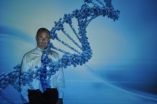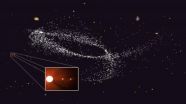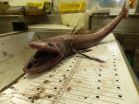First light for SPHERE exoplanet imager
2014-06-04
SPHERE passed its acceptance tests in Europe in December 2013 and was then shipped to Paranal. The delicate reassembly was completed in May 2014 and the instrument is now mounted on VLT Unit Telescope 3. SPHERE is the latest of the second generation of instruments for the VLT (the first three were X-shooter, KMOS and MUSE).
SPHERE combines several advanced techniques to give the highest contrast ever reached for direct planetary imaging — far beyond what could be achieved with NACO, which took the first ever direct image of an exoplanet. To reach its impressive performance ...
WSU researchers confirm 60-year-old prediction of atomic behavior
2014-06-04
PULLMAN, Wash.—Researchers at Washington State University have used a super-cold cloud of atoms that behaves like a single atom to see a phenomenon predicted 60 years ago and witnessed only once since.
The phenomenon takes place in the seemingly otherworldly realm of quantum physics and opens a new experimental path to potentially powerful quantum computing.
Working out of a lab in WSU's Webster Hall, physicist Peter Engels and his colleagues cooled about one million atoms of rubidium to 100 billionths of a degree above absolute zero. There was no colder place in the ...
New proactive approach unveiled to malware in networked computers and data
2014-06-04
Cybercrime comes in all forms these days. One recent headline told of the creepware or silent computer snooping that resulted in the arrest of some 90 people in 19 countries. Miss Teen USA was among the victims. Her computer had been turned into a camera and used to spy on her in her own bedroom.
On the commercial front, Target suffered the largest retail hack in U.S. history during the Christmas shopping season of 2013, and now the Fortune 500 company's outlook is bleak with steep drops in profits.
New research to be announced at the June 2014 ACM Symposium on Information, ...
Parasites fail to halt European bumblebee invasion of the UK
2014-06-04
A species of bee from Europe that has stronger resistance to parasite infections than native bumblebees has spread across the UK, according to new research at Royal Holloway, University of London.
The study, published today (Wednesday 4th June 2014) in the Journal of Animal Ecology, shows that tree bumblebees have rapidly spread despite them carrying high levels of an infection that normally prevents queen bees from producing colonies. The species arrived in the UK from continental Europe 13 years ago and has successfully spread at an average rate of nearly 4,500 square ...
Locked, loaded & feeling low: Dangers of gun ownership in the elderly
2014-06-04
In the United States the debate around gun ownership often focuses on teenagers; however, research shows that elderly Americans are the most likely to own a gun and that presents both medical and legal problems for physicians and carers.
Writing in the Journal of the American Geriatrics Society, Dr. Ellen Pinholt explores these issues and proposes a series of 'red flag' questions which caregivers must ask.
While there is no upper age limit on owning a firearm, Americans aged over 65 have the highest prevalence of dementia, depression and suicide. Federal law prohibits ...
Short intervals between pregnancies result in decreased pregnancy length
2014-06-04
Women who have short intervals between pregnancies of less than 18 months are more likely to see a decrease in the length of subsequent pregnancies, finds a new study published today (4 June) in BJOG: An International Journal of Obstetrics and Gynaecology.
The US study, using birth records from the Ohio Department of Health, looked at 454,716 live births from women with two or more pregnancies over a six year period. The researchers looked at the influence of inadequate birth spacing on the duration of the subsequent pregnancy.
The study defined short interpregnancy ...
Genes/adversity linked to crime in incarcerated sample
2014-06-04
HUNTSVILLE, TX (6/4/14) -- Researchers at Sam Houston State University have found a genetic characteristic that interacts with childhood adversity to predict higher rates of crime in an incarcerated sample.
The study is the first in a series that will examine contributions of genetic and environmental variations to criminal behavior. Published in Psychiatric Genetics, this study examines the role of monoamine oxidase A (MAOA), which has been linked to aggression, violence, and various types of childhood adversity in prior research. The study found MAOA genotype interacted ...
Count of new CFCs in the atmosphere rises from 4 to 7
2014-06-04
Scientists at the University of East Anglia have found two new chlorofluorocarbons (CFCs) and one new hydrochlorofluorocarbon (HCFC) in the atmosphere.
The research, published today in the journal Atmosphere, comes after another four man-made gases were discovered by the same team in March.
Scientists made the discovery by comparing today's air samples with air collected between 1978 and 2012 in unpolluted Tasmania, and samples taken during aircraft flights.
Measurements show that all but one of the new gases have been released into the atmosphere in recent years. ...
Astronomers discover ancient worlds from another galaxy next door
2014-06-04
An international team of scientists, led by astronomers at Queen Mary University of London, report of two new planets orbiting Kapteyn's star, one of the oldest stars found near the Sun. One of the newly-discovered planets could be ripe for life as it orbits at the right distance to the star to allow liquid water on its surface.
Discovered at the end of the 19th century and named after the Dutch astronomer who discovered it (Jacobus Kapteyn), Kapteyn's star is the second fastest moving star in the sky and belongs to the galactic halo, an extended cloud of stars orbiting ...
Iron, steel in hatcheries may distort magnetic 'map sense' of steelhead
2014-06-04
CORVALLIS, Ore. – Exposure to iron pipes and steel rebar, such as the materials found in most hatcheries, affects the navigation ability of young steelhead trout by altering the important magnetic "map sense" they need for migration, according to new research from Oregon State University.
The exposure to iron and steel distorts the magnetic field around the fish, affecting their ability to navigate, said Nathan Putman, who led the study while working as a postdoctoral researcher in the Department of Fisheries and Wildlife, part of OSU's College of Agricultural Sciences.
Just ...
Two planets orbit nearby ancient star
2014-06-04
Washington, D.C.— An international team of astronomers, including five Carnegie scientists, reports the discovery of two new planets orbiting a very old star that is near to our own Sun. One of these planets orbits the star at the right distance to allow liquid water to exist on its surface, a key ingredient to support life. Their work is published by Monthly Notices of the Royal Astronomical Society.
Kapteyn's Star, named after the Dutch astronomer, Jacobus Kapteyn, who discovered it at the end of the 19th century, is the second fastest-moving star in the sky and belongs ...
Deep sea fish remove 1 million tonnes of CO2 every year from UK and Irish waters
2014-06-04
Deep sea fishes remove and store more than one million tonnes of CO2 from UK and Irish surface waters every year, according to a new study led by the University of Southampton.
This natural carbon capture and storage scheme could store carbon equivalent to £10 million per year in carbon credits.
Fish living in deep waters on the continental slope around the UK play an important role carrying carbon from the surface to the seafloor.
It is assumed that deep water fishes all depend on particles that fall from the surface for their energy. These bottom-living deep water ...
The Lancet Psychiatry: Study shows increasing rates of premature death and violent crime in people with schizophrenia since 1970s
2014-06-04
New research, published in The Lancet Psychiatry journal, shows that rates of adverse outcomes, including premature death and violent crime, in people with schizophrenia are increasing, compared to the general population.
The results come from a unique study, led by Dr Seena Fazel, at Oxford University, UK, which analyses long-term adverse outcomes – including conviction for a violent crime (such as homicide or bodily harm) premature death (before the age of 56), and death by suicide – between 1972 and 2009 in nearly 25,000 people in Sweden diagnosed with schizophrenia ...
Pneumococcal conjugate vaccine is effective for preventing community-acquired pneumonia
2014-06-04
A 10-valent pneumococcal conjugate vaccine (PCV) is effective in reducing the number of new cases of likely-bacterial community-acquired pneumonia in infants in Latin America, according to a study published in this week's PLOS Medicine. Xavier Sáez-Llorens and colleagues from Department of Infectious Diseases, Panama found that the 10-valent PCV reduced the number of new cases of likely-bacterial community-acquired pneumonia in infants by 22% (95% CI: 7.7, 34.2) compared to those who received the control vaccine in the per-protocol cohort at the pre-planned interim analysis ...
Place and cause of death in centenarians: A population-based observational study in England
2014-06-04
Centenarians are more likely to die of pneumonia and frailty or "old age" and less likely to die of the chronic conditions often associated with old age, such as cancer or ischemic heart disease, compared with older adults younger than 100 years, according to a study by Catherine Evans and colleagues from King's College London, London, UK. Centenarians were most likely to die in a care home (61%) or hospital (27%) and less likely to die at home (10%) or in hospice care (0.2%). Higher care bed capacity was associated with fewer deaths of centenarians in hospital.
The ...
New health services needed for rise in 100-year-olds
2014-06-04
Over 35,000 people lived to 100 years or more in England over the last ten years, with a large proportion subsequently dying from frailty exacerbated by pneumonia, according to a new study by King's College London. With the number of centenarians set to grow, end-of-life care needs to be tailored to the increasing frailty in this age group, warn the King's palliative care researchers. Boosting care home capacity and planning health services for the rise in centenarians could help to reduce reliance on hospital admission at the end of life and ensure a better quality of ...
Unexpected diversity of egg yolk proteins play a key role in ant sociality and castes
2014-06-04
The social insects, including bees, wasps, ants and termites have developed a highly advanced society where division of labor amongst workers to serve the queen's reproduction has long fascinated biologists who have wanted to uncover the molecular pathways driving the complex behavior of insect societies.
In the advanced online edition of Molecular Biology and Evolution, Claire Morandin et al. performed molecular evolutionary analyses on the egg yolk forming protein, Vitellogenin (Vg), and its many forms, amongst seven Formica ant species. Vitellogenin is known to play ...
Discovering a hidden source of solar surges
2014-06-04
Cutting-edge observations with the 1.6-meter telescope at Big Bear Solar Observatory (BBSO) in California have taken research into the structure and activity of the Sun to new levels of understanding. Operated by New Jersey Institute of Technology (NJIT), the telescope at Big Bear is the most powerful ground-based instrument dedicated to studying the Sun.
A group of astronomers led by Dr. Santiago Vargas Domínguez has analyzed the highest- resolution solar observations ever made. A summary of their work at BBSO was presented on June 2 at the 224th meeting of the American ...
New device isolates most aggressive cancer cells
2014-06-04
ITHACA, N.Y. – Not all cancer cells are created equal – some stay put in the primary tumor, while others move and invade elsewhere. A major goal for cancer research is predicting which cells will metastasize, and why.
A Cornell cancer research team is taking a new approach to screening for these dangerous cells, using a microfluidic device they invented that isolates only the most aggressive, metastatic cells.
"The approach we've taken is a reverse approach from what is conventionally done," said Cynthia Reinhart-King, associate professor of biomedical engineering and ...
Many breast cancer patients don't get treatment for heart problems
2014-06-03
Only a third of older breast cancer patients saw a cardiologist within 90 days of developing heart problems, in a study presented at the American Heart Association's Quality of Care and Outcomes Research 2014 Scientific Sessions.
Breast cancer patients with heart problems who saw a cardiologist were more likely to receive standard therapy for their heart failure than those who did not see a heart specialist, the study found.
"The majority of older women who develop heart problems after their breast cancer therapy aren't treated by a cardiologist, and they had lower ...
Community program helps lower blood pressure among minorities
2014-06-03
Minorities at a higher risk of developing hypertension used a community-based program to significantly lower their blood pressure, researchers said at the American Heart Association's Quality of Care and Outcomes Research 2014 Scientific Sessions.
Minorities at a higher risk of developing hypertension used a community-based program to significantly lower their blood pressure, researchers said at the American Heart Association's Quality of Care and Outcomes Research 2014 Scientific Sessions.
Researchers assessed the use of the American Heart Association's Check. Change. ...
Implanted heart device linked to increased survival
2014-06-03
DURHAM, N.C. -- Implantable cardioverter defibrillators (ICDs) are associated with improved survival among heart failure patients whose left ventricles only pump 30 to 35 percent of blood out of the heart with each contraction, according to a study from the Duke Clinical Research Institute.
The findings, published in the June 4 issue of the Journal of the American Medical Association, support existing recommendations to implant ICDs in patients with a left ventricular ejection fraction (LVEF) – a measurement of how much blood is squeezed out of the heart – of 35 percent ...
High risk of recurrence of 2 life-threatening adverse drug reactions
2014-06-03
Individuals who are hospitalized for the skin conditions of Stevens-Johnson syndrome and toxic epidermal necrolysis appear to have a high risk of recurrence, according to a study in the June 4 issue of JAMA.
Stevens-Johnson syndrome (SJS) and toxic epidermal necrolysis (TEN) are life-threatening conditions that develop primarily as responses to drugs, and result in extensive epidermal detachment (upper layers of the skin detach from the lower layers). Recurrence has been reported in isolated cases, and the overall risk of recurrence has been unknown, according to background ...
Outcomes for older adults with pneumonia who receive treatment including azithromycin
2014-06-03
In a study that included nearly 65,000 older patients hospitalized with pneumonia, treatment that included azithromycin compared with other antibiotics was associated with a significantly lower risk of death and a slightly increased risk of heart attack, according to a study in the June 4 issue of JAMA.
Pneumonia and influenza together are the eighth leading cause of death and the leading causes of infectious death in the United States. Although clinical practice guidelines recommend combination therapy with macrolides (a class of antibiotics), including azithromycin, ...
Preventive placement of ICDs for less severe heart failure may improve survival
2014-06-03
An examination of the benefit of preventive placement of implantable cardioverter-defibrillators (ICDs) in patients with a less severe level of heart failure, a group not well represented in clinical trials, finds significantly better survival at three years than that of similar patients with no ICD, according to a study in the June 4 issue of JAMA.
Although clinical trials have established the ICD as the best currently available therapy to prevent sudden cardiac death in patients with heart failure, some uncertainties remain regarding preventive use of ICDs in patients ...
[1] ... [3445]
[3446]
[3447]
[3448]
[3449]
[3450]
[3451]
[3452]
3453
[3454]
[3455]
[3456]
[3457]
[3458]
[3459]
[3460]
[3461]
... [8703]
Press-News.org - Free Press Release Distribution service.






